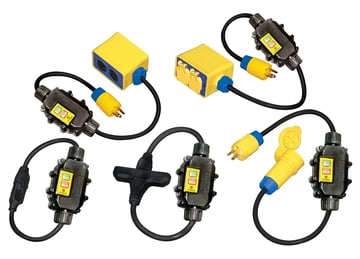July 20, 2016
Top Necessities For Proper Construction Site Power Distribution
Written by: Greg Brown
Temporary power distribution is common place on most construction sites, driven by the need to supply convenient portable power access for a wide array of portable tools and job site lighting. Safety electrical products should always be included in a construction’s schematic design(s), and all equipment should be National Electric Code (NEC) Compliant and Nationally Recognized Testing Laboratory (NRTL) Listed. Work site electrical safety products are required to be designed and manufactured to these standards. The goal is to have the safest available job site operation whether indoor, or while exposed to harsh environmental conditions.

Obtaining NEC and NRTL approval involves design and build compliance, to both electrical and mechanical requirements. They are based on specific user defined input power and secondary loading specifications.
Specific design requirements include:
- Input Connections
- Output Connections
- Corrosion Protection
- Current Carrying Part Capacity
- Overcurrent Protection
- Grounding and Bonding
- Electrical Insulation Material
- Enclosures and Enclosure Performance
Additional general requirements include:
- Temperature Ranges
- Strain Relief
- Icing / Gaskets
- Resistance to Rain / 3R In- use
- Spring Closing Cycling
- Metallic Coating Thickness
- Clamped-Joint Temperature
- Dielectric Voltage-Withstand Test
Properly designed temporary power distribution equipment not only contributes to the ongoing safety of everyone on the job site, but also protects against unnecessary equipment damage and downtime. As an example, NEC code requires that temporary cable, used to provide input power to temporary power distribution units, tool and lighting power, is to be protected in a shock resistant barrier. Cable protectors not only reduce pedestrian exposure to potentially hazardous voltages and trip points, but also minimize the possibility of downtime due to power outages.
Greg Brown
Greg Brown is an Applications Engineer.
More from the blog
View All Posts
Workplace Safety
2 min read
| December 1, 2016
7 Questions You Should Ask When Choosing Temporary Electrical Safety Products for Your Job Site
Read More
Wiring Devices
3 min read
| March 23, 2021
NEC Code Changes and Worker Safety
Read More
Workplace Safety
4 min read
| March 2, 2020
5 Ways to Protect Workers During Turnarounds & Shutdowns
Read MoreSubscribe to blog updates
Stay up-to-date on what's happening at this blog and get additional content about the benefits of subscribing.
